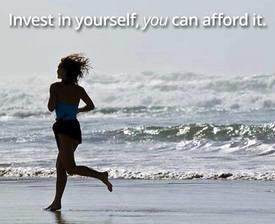Struggling to maintain
Replies
-
I eat every 3 hours.
That always makes me hungrier!
Like someone else mentioned, whenever I eat breakfast, I tend to overeat non-stop. This is when I'm living like a day person. For me, delaying my intake always worked better.
Working nights, it's almost the same. But on different hours.0 -
Are you eating more often? For me, my first meal starts the hunger cycle. When I was in weight loss mode, I typically skipped breakfast and ate a low calorie frozen meal for lunch in order to save my calories to have dinner with my family (small portions of whatever we were having...even fried chicken or pizza) followed by a small portion of dessert.
Once I moved to maintenance, I thought I could add back my favorite breakfast foods, but I found that if I ate breakfast, I actually felt more hungry a few hours later and was "starving" by lunch and tended to eat more than I did when I skipped breakfast altogether. Now, I delay my first meal until I'm really hungry (sometimes lunch, sometimes dinner, but rarely breakfast), and I generally have fewer hunger pangs than if I eat more often.
Just another idea in addition to the others offered here. It may just be a matter of experimenting until you figure out what works best for you.
I'm the SAME way!! Sometimes I don't get hungry 4/5 hours after I wake up!0 -
Yes, I have my stuff set to sedentary and add back exercise because my exercise is very unpredictable in terms of a schedule.
BUT, I set those other sites to sedentary as well! So, that doesn't quite explain it.
The other sites will adjust the daily calorie allowance depending on your activity level, MFP doesn't. Set the activity level to what you like and the daily calorie allowance doesn't change, it expects all exercised to be logged.0 -
Yes, I have my stuff set to sedentary and add back exercise because my exercise is very unpredictable in terms of a schedule.
BUT, I set those other sites to sedentary as well! So, that doesn't quite explain it.
The other sites will adjust the daily calorie allowance depending on your activity level, MFP doesn't. Set the activity level to what you like and the daily calorie allowance doesn't change, it expects all exercised to be logged.
But I set other sites according to sedentary, just like I set MFP to sedentary.
So, isnt it the same calculation? Where in both cases you eat back calories?0 -
Yes, I have my stuff set to sedentary and add back exercise because my exercise is very unpredictable in terms of a schedule.
BUT, I set those other sites to sedentary as well! So, that doesn't quite explain it.
The other sites will adjust the daily calorie allowance depending on your activity level, MFP doesn't. Set the activity level to what you like and the daily calorie allowance doesn't change, it expects all exercised to be logged.
But I set other sites according to sedentary, just like I set MFP to sedentary.
So, isnt it the same calculation? Where in both cases you eat back calories?
No, their calculations are going to be different because they are different types of calculators.0 -
Ah.0
-
Yes, sedentary on MFP is 1.25 x Mifflin BMR, normal TDEE tables are 1.2 x Harris or Mifflin BMR, if they tell you which one they use.
Some let you select Katch BMR if you know bodyfat %.0 -
So again it's all just estimated.
So start with the lower maintenance and up it if needed I guess right0 -
Actually no.
Studies show your body will adapt to lower eating levels by lowering metabolism.
You also risk burning off muscle mass when eating too little.
It's much safer to start higher, and then after a month figure out what the true maintenance must have been, and adjust down.
Less risk of just slowing metabolism down and risking muscle mass further slowing it down.
It's going to happen anyway as it takes less energy to move less mass, you'll lose some LBM from carrying less water, but no need to lose muscle or LBM before it's time, extra metabolism.0 -
No, you don't have to ignore hunger or cravings. When you eat, focus on the specific foods that satisfy hunger.
http://www.mendosa.com/satiety.htm
I eat this way and can vouch for it, especially oranges and whole eggs. It really works, I am rarely starving or craving. I don't eat sugar or artificial sweetners, ever.0 -
bump0
-
No, you don't have to ignore hunger or cravings. When you eat, focus on the specific foods that satisfy hunger.
http://www.mendosa.com/satiety.htm
I eat this way and can vouch for it, especially oranges and whole eggs. It really works, I am rarely starving or craving. I don't eat sugar or artificial sweetners, ever.
Im confused, are the foods with the higher percentage more filling or less?0 -
That is the most confusing website I've ever seen. I'd ignore that specific site, but the premise is right on. Foods higher in protein and fat keep most people feeling full longer. (Not everyone, I have a friend that is much more satiated by carbs, and she can get seriously hangry if she tries low carb.) That does prove a point though, satiety is personal. Some people need to eat five meals a day to feel full, others eat two. Some people love carbs to fill them up, others eat mainly protein.No, you don't have to ignore hunger or cravings. When you eat, focus on the specific foods that satisfy hunger.
http://www.mendosa.com/satiety.htm
I eat this way and can vouch for it, especially oranges and whole eggs. It really works, I am rarely starving or craving. I don't eat sugar or artificial sweetners, ever.
Im confused, are the foods with the higher percentage more filling or less?
If what you're eating now isn't keeping you satiated, try adding/replacing something. Personally, I used to eat cereal for breakfast, and two hours later I wanted to gnaw my arm off (and I'd get low blood sugar; found out I have reactive hypoglycemia). I've learned that adding more protein and fat keeps me full longer. Right now I have peanut butter, a protein shake, and some soy milk for breakfast. I've also done overnight oats as well (soy milk, greek yogurt, and oats). Higher protein and higher fats may help you to feel full.
ETA: Seriously? That chart says jelly beans have more satiety than muesli...0 -
More satisfying. Look at boiled potatoes, porridge/oatmeal, oranges, apples, grapes, beef, baked beans, eggs, cheese, brown pasta, whole grain bread.
If I get really hungry I'll eat boiled eggs and oranges. My hunger drops like a stone. I eat a lot of cheese and whole fruit for snacks and meals. Friend me and you can go through my diary if you like. I'm maintaining and playing with my calories now looking for the right maintenance calories.0 -
That is the most confusing website I've ever seen. I'd ignore that specific site, but the premise is right on. Foods higher in protein and fat keep most people feeling full longer. (Not everyone, I have a friend that is much more satiated by carbs, and she can get seriously hangry if she tries low carb.) That does prove a point though, satiety is personal. Some people need to eat five meals a day to feel full, others eat two. Some people love carbs to fill them up, others eat mainly protein.No, you don't have to ignore hunger or cravings. When you eat, focus on the specific foods that satisfy hunger.
http://www.mendosa.com/satiety.htm
I eat this way and can vouch for it, especially oranges and whole eggs. It really works, I am rarely starving or craving. I don't eat sugar or artificial sweetners, ever.
Im confused, are the foods with the higher percentage more filling or less?
If what you're eating now isn't keeping you satiated, try adding/replacing something. Personally, I used to eat cereal for breakfast, and two hours later I wanted to gnaw my arm off (and I'd get low blood sugar; found out I have reactive hypoglycemia). I've learned that adding more protein and fat keeps me full longer. Right now I have peanut butter, a protein shake, and some soy milk for breakfast. I've also done overnight oats as well (soy milk, greek yogurt, and oats). Higher protein and higher fats may help you to feel full.
ETA: Seriously? That chart says jelly beans have more satiety than muesli...
Go away negative person. Go smear your negativity on someone else.0
This discussion has been closed.
Categories
- All Categories
- 1.4M Health, Wellness and Goals
- 398.3K Introduce Yourself
- 44.7K Getting Started
- 261K Health and Weight Loss
- 176.4K Food and Nutrition
- 47.7K Recipes
- 233K Fitness and Exercise
- 462 Sleep, Mindfulness and Overall Wellness
- 6.5K Goal: Maintaining Weight
- 8.7K Goal: Gaining Weight and Body Building
- 153.5K Motivation and Support
- 8.4K Challenges
- 1.4K Debate Club
- 96.5K Chit-Chat
- 2.6K Fun and Games
- 4.7K MyFitnessPal Information
- 17 News and Announcements
- 21 MyFitnessPal Academy
- 1.5K Feature Suggestions and Ideas
- 3.2K MyFitnessPal Tech Support Questions







